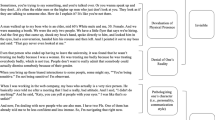Abstract
This study defines contrapower harassment in academia as student incivility, bullying, and sexual attention aimed at faculty. A U.S., Alaskan sample of 399 professors (50% women, 88% white) at the state’s largest public university was surveyed about their experience with contrapower harassment. Although men reported more sexual attention from students and comparable levels of student incivility–bullying, women reported that such behaviors were more upsetting and had a greater negative impact on their health and work-lives; they were also more likely to take action following such experiences than men. Tenure-track faculty appear to be at increased risk of student hostility. Discussion focuses on how gender and other markers of socio-cultural or institutional power relate to the experience of contrapower harassment.
Similar content being viewed by others
References
Benson, K. A. (1984). Comments on Crocker’s ‘An Analysis of University Definitions of Sexual Harassment. Signs, 9, 516–519.
Buchanan, N. T. (2005). The nexus of race and gender domination: Racialized sexual harassment of African American women. In P. Morgan, & J. Gruber (Eds.), In the Company of Men: Re-Discovering the Links Between Sexual Harassment and Male Domination (pp. 294–320). Boston: Northeastern University Press.
Carroll, L., & Ellis, K. (1989). Faculty attitudes toward sexual harassment: survey results, survey process. Initiatives, 52, 35–41.
Darby, J. A. (2006). The effects of the elective or required status of courses on student evaluations. Journal of Vocational Education and Training, 58, 19–29.
Delucchi, M., & Korgen, K. (2002). We’re the customer—we pay the tuition: student consumerism among undergraduate sociology majors. Teaching Sociology, 30, 100–107.
DeSouza, E., & Fansler, G. A. (2003). Contrapower sexual harassment: a survey of students and faculty members. Sex Roles, 48, 529–542.
DeSouza, E. R., & Ribeiro, J. (2005). Bullying and sexual harassment among Brazilian high school students. Journal of Interpersonal Violence, 20, 1018–1038.
Grauerholz, E. (1989). Sexual harassment of women professors by students: exploring the dynamics of power, authority, and gender in a university setting. Sex Roles, 21, 789–801.
Gutek, B. A. (1985). Sex and the workplace. San Francisco: Jossey-Bass.
Hardy, M. A. (1993). Regression with dummy variables. Newbury Park, CA: Sage.
Heilman, M. E. (2001). Description and prescription: how gender stereotypes prevent women’s ascent up the organizational ladder. The Journal of Social Issues, 57, 657–674.
Heilman, M. E., & Okimoto, T. G. (2007). Why are women penalized for success at males tasks?: The implied communality deficit. The Journal of Applied Psychology, 92, 81–92.
Josephson Institute of Ethics. (2002). Survey documents decade of moral deterioration: Kids today are more likely to cheat, steal, and lie than kids 10 years ago. The Ethics of American Youth 2002 Report Card. Retrieved June 16, 2007 from www. Josephsoninstitute.org/Survey2002/survey2002-pressrelease.htm.
King, J. E. (1998, May 1). Too many students are holding jobs for too many hours. The Chronicle of Higher Education.
Konrad, A. M., & Gutek, B. A. (1986). Impact of work experiences on attitudes toward sexual harassment. Administrative Science Quarterly, 31, 422–438.
Lapierre, L. M., Spector, P. E., & Leck, J. D. (2005). Sexual versus nonsexual workplace aggression and victims’ overall job satisfaction: a meta-analysis. Journal of Occupational Health Psychology, 10, 155–169.
Maas, A., & Cadinu, M. R. (2006). Protecting a threatened identity through sexual harassment: A social identity interpretation. In R. Brown, & D. Capozza (Eds.), Social Identities: Motivational, Emotional, and Cultural Influences (pp. 109–131). Hove, UK: Psychology.
Matchen, J., & DeSouza, E. (2000). The sexual harassment of faculty members by students. Sex Roles, 41, 295–306.
McKinney, K. (1990). Sexual harassment of university faculty by colleagues and students. Sex Roles, 23, 421–438.
Miller, J., & Chamberlin, M. (2000). Women are teachers, men are professors: a study of student perceptions. Teaching Sociology, 28, 283–298.
Morrissette, P. J. (2001, May 14). Reducing incivility in the university/college classroom. International Electronic Journal for Leadership in Learning, 5(4), 12.
Myers, D. G. (2008). Social psychology (9th ed.). Boston, MA: McGraw-Hill.
Nydegger, R., Paludi, M., DeSouza, E. R., & Paludi, C. A. (2006). Incivility, sexual harassment, and violence in the workplace. In M. F. Karsten (Ed.), Gender, Race, and Ethnicity in the Workplace: Issues and Challenges for Today’s Organizations: Vol. 2. Legal, Psychological, and Power Issues Affecting Women and Minorities in Business (pp. 51–81). Westport, CT: Praeger.
Ólafsson, R. F., & Jóhannsdóttir, H. L. (2004). Coping with bullying in the workplace: the effect of gender, age and type of bullying. British Journal of Guidance & Counselling, 32, 319–333.
Paludi, M. A., & Barickman, R. B. (1998). Sexual harassment, work, and education: A resource manual for prevention (2nd ed.). Albany, NY: State University of New York Press.
Rospenda, K. M., Richman, J. A., & Nawyn, A. J. (1998). Doing power: The confluence of gender, race, and class in contrapower sexual harassment. Gender & Society, 12, 40–60.
Rudman, L. A., & Glick, P. (2008). The social psychology of gender: How power and intimacy shape gender relations. New York: Guilford.
Schneider, A. (1998, March 27). Insubordination and intimidation signal the end of decorum in many classrooms. The Chronicle of Higher Education.
Sprague, J., & Massoni, K. (2005). Student evaluations and gendered expectations: what we can’t count can hurt us. Sex Roles, 53, 779–793.
Thacker, R. A., & Gohmann, S. F. (1996). Emotional and psychological consequences of sexual harassment: A descriptive study. The Journal of Psychology, 130, 429–446.
Twenge, J. M. (2006). Generation me: Why today’s young Americans are more confident, assertive, entitled—and more miserable than ever before. New York: Free Press.
Author information
Authors and Affiliations
Corresponding author
Rights and permissions
About this article
Cite this article
Lampman, C., Phelps, A., Bancroft, S. et al. Contrapower Harassment in Academia: A Survey of Faculty Experience with Student Incivility, Bullying, and Sexual Attention. Sex Roles 60, 331–346 (2009). https://doi.org/10.1007/s11199-008-9560-x
Received:
Accepted:
Published:
Issue Date:
DOI: https://doi.org/10.1007/s11199-008-9560-x



